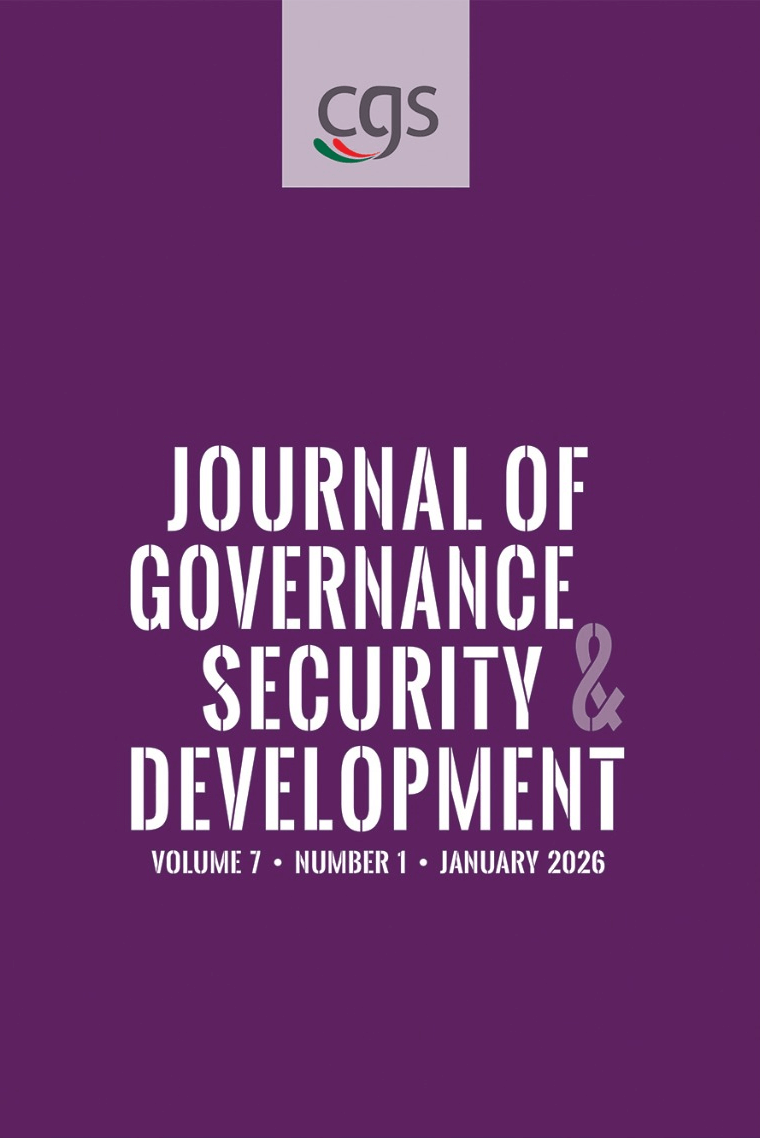Journal Reference
Volume 7 | Number 1 | Online Early Version
Online Version: ISSN No: 2708-2490
Print Version: ISSN No: 2709-0590
Price: BDT: 750.00, USD: 25.00
Publish Date: 14, October 2025
Article:
Ayesha Siddika, Nowshin Nawar, Nabiha Tahsin Nisa, Shihab Shahriar, and S.K.NabilRahman
Reference
Ahammad, S. U. (2017). The dynamics of agricultural land management system in Bangladesh: The challenges for sustainable development. American Journal of Rural Development, 5(1), 5-18. doi:10.12691/ajrd-5-1-2
Akhter, R. (2020). Challenges of land services delivery and effectiveness of emutation in Bangladesh: a study on land mutation at Maheshpur upazila Jhenaidah. Brac Institute of Governance and Development (BIGD), 51-60.
Akter, M. (2022). Digitalization in the Land Service Delivery: Comparison between Bangladesh and Indonesia. Southeast Asia: A Multidisciplinary Journal, 22(1), 79-92. https://www.emerald.com/insight/content/doi/10.1108/seamj-01-2022-b1006/full/pdf?title=digitalization-in-the-land-service-delivery-comparison-between-bangladesh-and-indonesia
Ali, M. Y., Pasha, G. M., Jahan, K.,& Paul, P. (2024). The impact of e-services on people’s empowerment: An investigation into e-mutation service of Bangladesh. Khulna University Studies, 21(2), 192-197. https://kus.ku.ac.bd/kustudies/article/view/1177/1985
Arifuzzaman, M.,& Islam, S. (2024). Digitalization of land documents in Bangladesh: Challenges and prospects. Scientific Research Publishing, 11(10), 9-12. http://dx.doi.org/10.4236/oalib.1112101
Asaduzzaman, M. (2008). Governance in Practice: Decntralization and People's Paticipation in the Local Development of Bangladesh. Tampere: University of Tampere.
Aziz, M. A. (2004). Land record system in Bangladesh: an analysis of problems and possible solutions. NDC Journal, 3(1), 79-82. https://ndcjournal.ndc.gov.bd/ndcj/index.php/ndcj/article/view/16/13
Begum, S. (2023). Citizens' perspective on land e-mutation at upazila land offices in Mymensingh. Asian Journal of Social Sciences and Legal Studies, 5(6), 291-305. https://www.universepg.com/public/img/storage/journal-pdf/HIGHLI~1.PDF
Bhuiyan, M. J., Islam, S., Mamun, M., & Hosen, S. (2022). The role of citizen charter in accelerating public service delivery in land management: A case study of upazila land offices. Bangladesh Journal of Public Administration, 30(3), 26-50.
Braun, V.,& Clarke, V. (2019). Reflecting on reflexive thematic analysis. Qualit Res Sport Exercise Health, 11(4), 589–597. https://doi.org/10.1080/2159676X.2019.1628806
Brooks, L.,& Alam, M.S. (2017). Affordance and Habitus: Understanding Land Records E-services in Bangladesh. In Choudrie, J., Islam, M., Wahid, F., Bass, J.&Priyatma, J. (Eds.),Information and Communication Technologies for Development. ICT4D 2017. IFIP Advances in Information and Communication Technology, Vol. 504, pp. 267–278). Springer. https://doi.org/10.1007/978-3-319-59111-7_25
Bukth, T.,& Khan, R. H. (2024). Impact of e-governance in a developing country: The case of e-mutation in Bangladesh. Bangladesh Journal of MIS, 10(1), 56-65. https://doi.org/10.61606/BJMIS.V10N1.A3
Choudhury, E., Ridwan, M., Awal, M., & Hossain, S. (2011). A web-based land management system for Bangladesh. 14th International Conference on Computer and Information Technology (ICCIT 2011), pp. 321-326, doi: 10.1109/ICCITechn.2011.6164807.
Chowdory, U.,& Moin, M. (2024). Overview of Governance and Rampant Corruption in Land Administration in Bangladesh. Asian Journal of Social Science and Humanities, 5(5), 9-11. doi:10.48165/sajssh.2024.5509
Davis, F. (1987). User acceptance of information systems: The Technology Acceptance Model (TAM). Working Paper, No. 529. School of Business Administration, University of Michigan. https://quod.lib.umich.edu/b/busadwp/images/b/1/4/b1409190.0001.001.pdf
Emam, J. (2022). The prospect of integrated land administration and management system (ILAMS) for improving land related service delivery in Bangladesh. Bangladesh Journal of Public Administration, 30(2), 47-62. https://doi.org/10.36609/bjpa.v30i2.360
Felber, N.A., Lipworth, W., Tian, Y.J. Schwab, D. R.,& Wangmo, T. (2024). Informing existing technology acceptance models: a qualitative study with older persons and caregivers. European Journal of Ageing, 21(12). https://doi.org/10.1007/s10433-024-00801-5
Fereday, J., & Muir-Cochrane, E. (2006). Demonstrating Rigor Using Thematic Analysis: A Hybrid Approach of Inductive and Deductive Coding and Theme Development. International Journal of Qualitative Methods, 5(1), 80-92. https://doi.org/10.1177/160940690600500107
Haque, A., Ullah, S., Sikdar, M., Shohag, M. H., Ahmed, M., Masuda, M., & Alam, M. (2022). Integrating Environmental Governance into Sustainable Urban Development in Bangladesh. International Journal of Sustainable Development and Planning, 17(5), 1471-1478. https://iieta.org/sites/default/files/pdf/2022-09/17.05_11.pdf
Hasan, M. I. (2017). Land administration in Bangladesh: Problems and analytical approach to solution. International Journal of Law, 3(2), 44-49. https://www.lawjournals.org/assets/archives/2017/vol3issue2/3-1-39-601.pdf
Hasan, N. A. (2024). ‘Mutating Records’—Bureaucratic knowledge in the realm of splintering digitality. Contributions to Indian Sociology, 57(3), 329-355. https://doi.org/10.1177/00699659231195466
Hasan, S., & Gourab, A. H. (2023). Impacts of e-mutation: A study on service recipients’ perception. BIGM Journal of Policy Analysis, 1(1), 14-18. https://doi.org/10.58718/policyanalysis1120234
Hossain, M. (2015). Improving land administration and management in Bangladesh. Dhaka: Bangladesh Institute of development Studies (BIDS). https://gedkp.gov.bd/wp-content/uploads/2021/02/4_Improving-Land-Administration-and-Management_Final-1.pdf
Islam, S. (2023). An overview of the legal status of land ownership in Bangladesh. British Journal of Arts and Humanities, 5(2), 68-77. https://doi.org/10.34104/bjah.023068077
Madon, S. (2009). e-Governance for development. Palgrave Macmillan.https://doi.org/10.1057/9780230250499_4
Mohiuddin, T. (2008). Land administration in Bangladesh: Mismanagement through misfeasance. Jahangirnagar University Planning Review,1, 2-13
Muna, S. H., Ahmed, S., & Baniamin, H. M. (2024). Uncharted territories: Exploring e-mutation for sustainable governance in land administration.In Zafarullah, H., &Azmat, F. (Eds.),Governance and Sustainable Development in South Asia (pp. 279-286). Springer https://doi.org/10.1007/978-3-031-67616-1_15
Parvin, M. A., Haque, M. I., Hossain, M. A., & Bashar, A. (2023). In Index-based change detection, spatial zoning and environmental criticality of urban land cover: A spatiotemporal study on Gazipur Sadar Upazila of Bangladesh. Journal of Geography, Environment and Earth Science International, 27(10), 145–163. https://doi.org/10.9734/jgeesi/2023/v27i10722
Rahman, M., &Korobi, S. A. (2024). Unraveling rural land conflicts in Bangladesh: Stakeholders, power dynamics, and paths to resolution. Asian Review of Social Sciences, 13(1), 1-16. https://www.arssjournal.org/index.php/arss/article/view/4065/7584
Rashid, M. R., Rafi, A. A., Islam, M., Sharkar, S. U., Rafi, Z. H., Hasan, M., &Khan, M. H. (2025). Enhancing land management policy in Bangladesh: A blockchain-based framework for transparent and efficient land management. Land Use Policy, 150.https://doi.org/10.1016/j.landusepol.2024.107436.
Roy, S. K., & Chowdhury, S. (2024). Citizen’s attitude toward the use of open data in e-governance. In A. Haque & Y. Salman (Eds.), Perspectives and Practices of Public Administration in South Asia (pp. 79–94). Springer.https://doi.org/10.1007/978-3-031-49841-1_5
Saha, J., Ria, S. S., Sultana, J., Shima, U. A., Seyam, M. M. H., & Rahman, M. M. (2024). Assessing seasonal dynamics of land surface temperature (LST) and land use land cover (LULC) in Bhairab, Kishoreganj, Bangladesh: A geospatial analysis from 2008 to 2023. Case Studies in Chemical and Environmental Engineering, 9, 100560. https://doi.org/10.1016/j.cscee.2023.100560
Saif, A. N., &Hawlader, M. (2018). Land e-mutation system in Bangladesh: An exploratory study of a2i program. Journal of Green Business School, 1(1), 20-23. https://siteadmin.green.edu.bd/uploads/documents/journal-article/2_1700195587_article-document.pdf
Scanlan, O., Siraj, N., Ritchil, P., & Mankin, S. (2024). Is ‘pro-poor land administration’ a realistic proposition? How a land survey in Bangladesh reproduced and reconfigured gendered and racialised poverty. Land Use Policy, 138, 13-15. https://www.sciencedirect.com/science/article/abs/pii/S0264837723004829
Silva, P. (2015). Davis' technology acceptance model (TAM)(1989).In M. Al-Suqri& A. Al-Aufi (Eds.),Information Seeking Behavior and Technology Adoption: Theories and Trends, (pp. 205-219). IGI Global Scientific Publishing. https://doi.org/10.4018/978-1-4666-8156-9.ch013
Talukder, S. K. (2019). Effectiveness and Challenges of Scaling Up e-Mutation in Bangladesh. BRAC Institute of Governance and Development. https://bigd.bracu.ac.bd/study/effectiveness-and-challenges-of-scaling-up-e-mutation-in-bangladesh/
Zhu, M.,& Zhang, Y. (2022). Medical and public health instructors’ perceptions of online teaching: A qualitative study using the Technology Acceptance Model 2. Education and Information Technologies, 27, 2385–2405. https://doi.org/10.1007/s10639-021-10681-2


